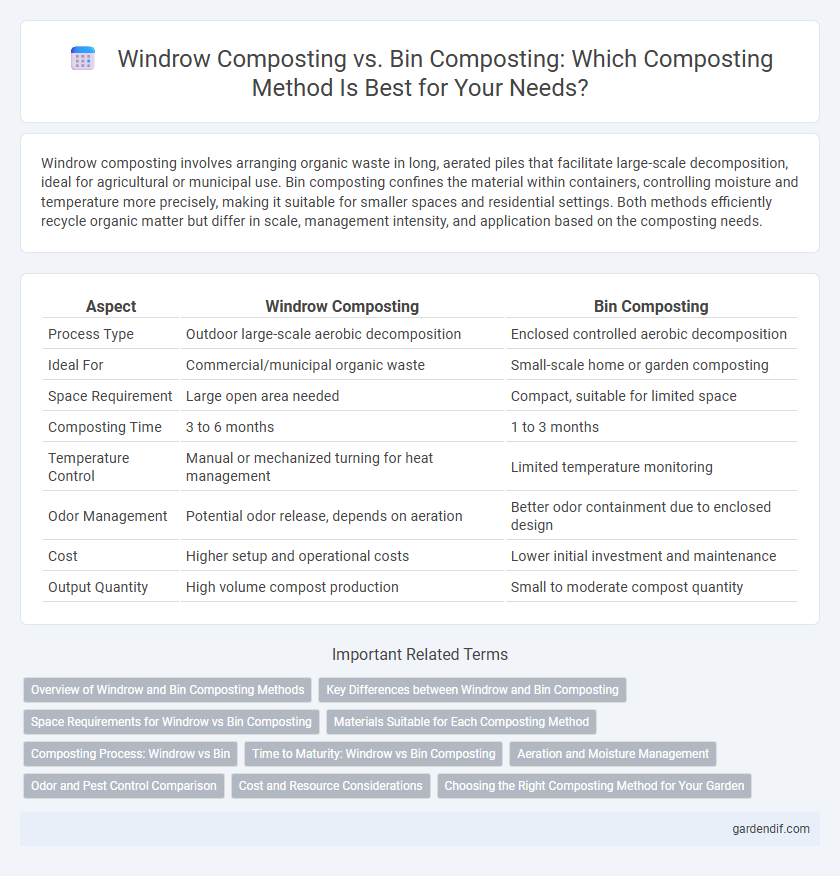
Windrow composting vs Bin composting Illustration
Windrow composting involves arranging organic waste in long, aerated piles that facilitate large-scale decomposition, ideal for agricultural or municipal use. Bin composting confines the material within containers, controlling moisture and temperature more precisely, making it suitable for smaller spaces and residential settings. Both methods efficiently recycle organic matter but differ in scale, management intensity, and application based on the composting needs.
Table of Comparison
| Aspect | Windrow Composting | Bin Composting |
|---|---|---|
| Process Type | Outdoor large-scale aerobic decomposition | Enclosed controlled aerobic decomposition |
| Ideal For | Commercial/municipal organic waste | Small-scale home or garden composting |
| Space Requirement | Large open area needed | Compact, suitable for limited space |
| Composting Time | 3 to 6 months | 1 to 3 months |
| Temperature Control | Manual or mechanized turning for heat management | Limited temperature monitoring |
| Odor Management | Potential odor release, depends on aeration | Better odor containment due to enclosed design |
| Cost | Higher setup and operational costs | Lower initial investment and maintenance |
| Output Quantity | High volume compost production | Small to moderate compost quantity |
Overview of Windrow and Bin Composting Methods
Windrow composting involves arranging organic waste in long, aerated piles that are regularly turned to enhance microbial activity and accelerate decomposition, making it suitable for large-scale operations with bulky materials like yard waste and agricultural residues. Bin composting uses enclosed containers or bins to contain the organic matter, providing controlled conditions and reducing odors, ideal for small-scale or urban composting with kitchen scraps and garden waste. Both methods promote aerobic decomposition but differ in scale, management intensity, and space requirements.
Key Differences between Windrow and Bin Composting
Windrow composting involves piling organic waste into long rows, allowing natural aeration through periodic turning, which speeds up decomposition and suits large-scale operations. Bin composting confines waste within containers, controlling moisture and temperature more effectively, making it ideal for smaller spaces and urban settings. Key differences include scale, aeration method, and management intensity, influencing the efficiency and applications of each composting technique.
Space Requirements for Windrow vs Bin Composting
Windrow composting requires significantly more space, often needing large outdoor areas to accommodate the lengthy piles or "windrows" that can extend several meters in length and width. Bin composting is ideal for limited spaces such as urban gardens, using contained units that typically occupy minimal ground area while maintaining effective decomposition conditions. The choice between the two methods largely depends on the available land, with windrow systems suited for farms or industrial sites and bin composting favored for households and small-scale composters.
Materials Suitable for Each Composting Method
Windrow composting efficiently processes large volumes of bulky organic materials such as yard waste, crop residues, and livestock manure due to its open-air, aerated piles. Bin composting is more suitable for kitchen scraps, small-scale garden waste, and food residues, providing controlled conditions that minimize odors and pests. Selecting the right composting method depends on the material's particle size, moisture content, and the available space for decomposition.
Composting Process: Windrow vs Bin
Windrow composting involves creating long piles turned periodically to aerate organic material, enabling efficient microbial activity and faster decomposition. Bin composting confines organic waste in enclosed containers, allowing better temperature control but slower aeration and decomposition rates. Windrow systems are ideal for large-scale composting with high volumes, while bin composting suits smaller spaces and households.
Time to Maturity: Windrow vs Bin Composting
Windrow composting typically requires 2 to 4 months to reach maturity due to larger pile sizes and enhanced microbial activity from periodic turning. Bin composting often takes longer, around 3 to 6 months, since limited oxygen and space can slow decomposition rates. Efficient aeration and moisture control are critical factors influencing the overall time to maturity in both methods.
Aeration and Moisture Management
Windrow composting relies on regular turning to enhance aeration and maintain optimal moisture levels, supporting aerobic microbial activity in large, exposed piles. Bin composting offers more controlled conditions, with restricted airflow that can lead to moisture retention challenges and potential anaerobic zones if not properly managed. Effective aeration in windrows prevents odor and accelerates decomposition, whereas bins require manual intervention or specialized designs to balance moisture and oxygen for efficient composting.
Odor and Pest Control Comparison
Windrow composting produces higher odor levels due to larger, open piles that enhance microbial activity but also release more gases, increasing nuisance risks. Bin composting offers better odor containment by restricting airflow and maintaining controlled moisture, significantly reducing pest attraction and odor escape. Effective pest control in bin systems results from physical barriers preventing access, whereas windrow systems require frequent turning and management to minimize pest issues.
Cost and Resource Considerations
Windrow composting requires larger land area and heavy machinery, leading to higher initial setup and operational costs compared to bin composting. Bin composting is more cost-effective for small-scale or urban settings, utilizing limited space and minimal equipment, but may demand more frequent manual labor. Resource allocation must consider scale, with windrow systems ideal for large volumes due to efficient aeration and turning, while bins suit smaller quantities with slower decomposition rates.
Choosing the Right Composting Method for Your Garden
Windrow composting suits larger gardens or farms by efficiently handling bulky organic waste through aerobic decomposition in long, turned piles, promoting faster breakdown. Bin composting works well for smaller spaces, offering controlled conditions that reduce pests and odors by containing materials within enclosed containers. Assess garden size, available space, and waste volume to select the method that optimizes nutrient-rich compost production tailored to your gardening needs.
Windrow composting vs Bin composting Infographic

 gardendif.com
gardendif.com